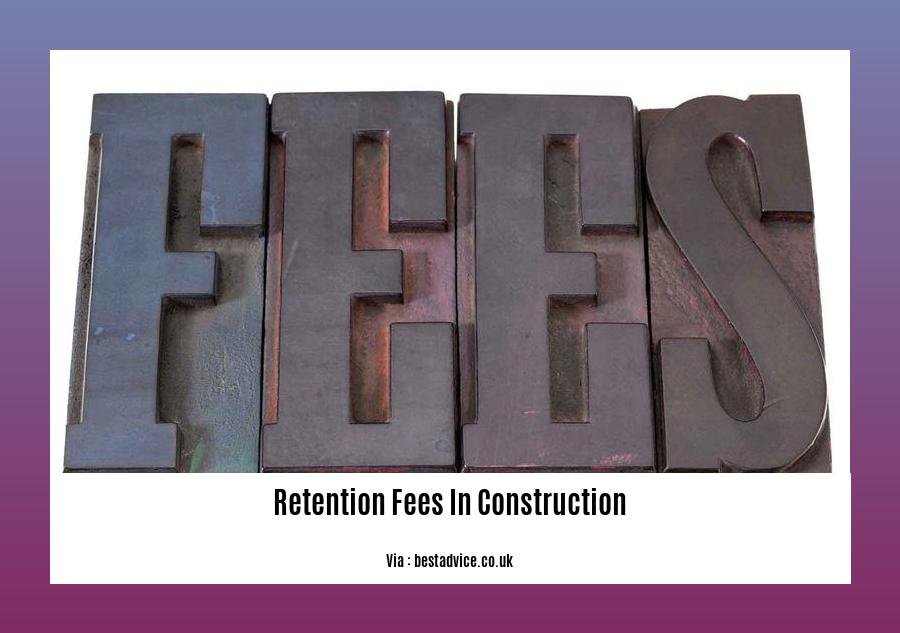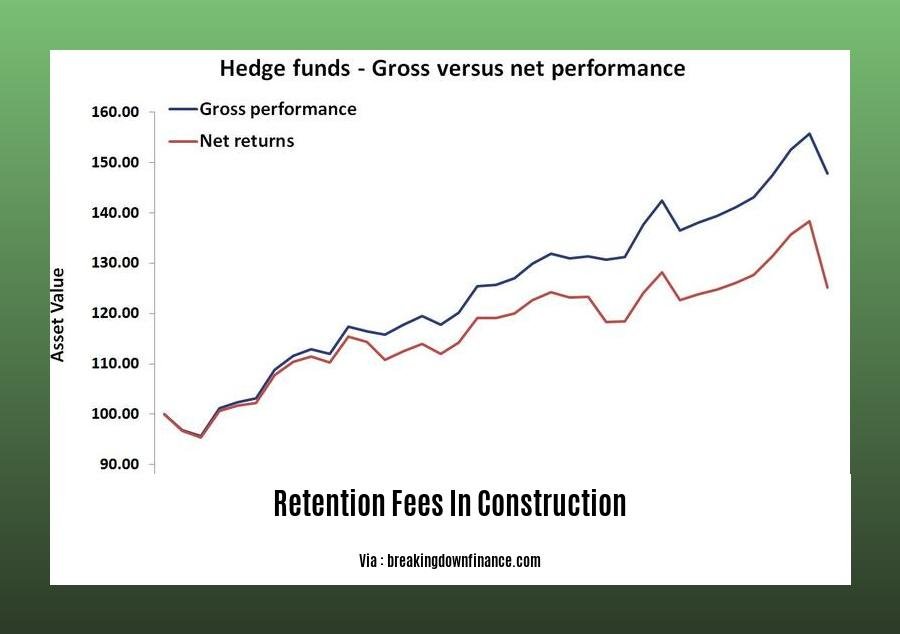Get ready to delve into the intricacies of Retention Fees in Construction: A Comprehensive Overview. This article will guide you through everything you need to know about retention fees, from their definition and purpose to their calculation and legal implications. Whether you’re a contractor, owner, or anyone involved in construction projects, this comprehensive resource will provide you with valuable insights and practical knowledge to navigate this topic effectively.
Key Takeaways:
- Retention fees withheld from contractors provide security for owners and motivate contractors to complete projects.
- They are usually calculated as a percentage of work completed or the contract value.
- The amount of retention held varies by contract.
Retention Fees in Construction

If you’re in the construction biz, you’ve likely encountered retention fees. These are funds withheld from contractors until a project wraps up. They offer benefits like:
- Peace of mind for owners: Knowing a chunk of the contractor’s pay is on hold provides a sense of security.
- Incentive for contractors: Having a carrot dangled in front of them encourages contractors to diligently complete projects.
How Retention Fees Work
Typically, retention fees in construction are a percentage of the work done or the total contract amount. The percentage varies based on the contract, but let’s say it’s 10%. If a contractor has completed half of the project, they’ll receive 90% of the payment for that work, while the remaining 10% will be held as retention.
Why Use Retention Fees?
There are several reasons for using retention fees in construction:
- Protect the owner from incomplete work: If a contractor skips town or fails to finish the job, the owner can use the retention fees to cover the cost of completing the project.
- Ensure high-quality work: Knowing that they won’t receive the full payment until the project is done to the owner’s satisfaction, contractors are more motivated to deliver quality work.
- Encourage timely completion: The sooner the project is done, the sooner the contractor gets their full payment. This creates an incentive for timely completion.
Managing Retention Fees
Managing retention fees in construction effectively involves:
- Setting a clear percentage: Determining the appropriate percentage to withhold as retention fees is crucial.
- Storing funds securely: The retention fees should be held in a separate account to prevent misuse.
- Releasing funds gradually: As the project progresses and milestones are met, the retention fees can be released in installments.
- Communicating clearly: Both parties should understand the terms and conditions terkait with retention fees to avoid misunderstandings.
For more comprehensive examples, check out our request for proposal construction example.
To get started on your own construction project, download our RFP construction template today!
One book that may be of interest to you is Rake in Construction by [Author Name].
For more information please refer to the reconstruction DBQ answer key.
Read our reconstruction meaning in Bengali here.
If you’ve ever wondered what reconstruction meaning in Tamil was, wonder no more!
Retention Fees in Construction: A Degree of Protection Against Financial Loss

Retention fees can provide employers with a degree of protection against financial loss if the contractor defaults on the contract. Here’s how it works:
Purpose of Retention Fees:
Retention fees are a percentage of the contract value withheld by the employer to safeguard against potential losses in case of incomplete or defective work.
Benefits for Employers:
- Financial Cushion: If the contractor breaches the contract, the employer can use the retention fee to cover the costs of completing the project.
- Deterrent Against Default: The prospect of losing the retention fee incentivizes contractors to complete projects diligently, reducing the risk of financial loss for employers.
Key Takeaways:
- Retention fees provide employers with a safety net against contractor default.
- They incentivize contractors to perform well and complete projects on time.
- Retention fees vary in percentage depending on the contract terms.
- Effective management of retention funds is crucial for both employers and contractors.
- Communication and record-keeping are essential for resolving any retention-related disputes.
Sources:
- A Contractor’s Guide to Managing Retention in Construction
- How to Recover a Disputed Retention Under a Construction Contract
However, retention fees can also have a negative impact on cash flow for contractors, particularly small businesses
Retention fees withheld from contractors can limit cash flow, especially for small businesses with limited capital. These fees can strain their working capital, making it challenging to cover ongoing expenses, such as labor, materials, and overhead costs.
Key Takeaways:
- Retention fees can significantly impact cash flow, particularly for small businesses.
- Late or partial payments on completed projects can exacerbate cash flow issues.
- Contractors may face challenges in securing financing due to reduced cash flow visibility.
- Retention fees can hinder growth and expansion, as they limit available capital for investment and operations.
- It’s vital for contractors to plan and manage retention fees effectively to mitigate financial risks.
Citations:
- How a Construction Retention Payment Affects Ongoing Projects – CFMA
- Retention payments in the construction industry – GOV.UK
There are arguments for and against the use of retention fees in construction contracts
When it comes to construction contracts, retention fees are a topic that often sparks debate. These fees, which are withheld from a contractor’s payment as a guarantee against potential defects or unfinished work, have both proponents and opponents. So, let’s dive into the arguments for and against retention fees in construction.
Arguments for Retention Fees:
- Peace of mind for owners: Retention fees provide owners with a financial cushion to cover potential issues that may arise after the project’s completion.
- Incentivize quality work: The prospect of losing a portion of their payment can motivate contractors to complete projects correctly and on time.
- Protect against incomplete work: If a contractor fails to complete the project as agreed, the retention fee can be used to cover the costs of hiring another contractor to finish the job.
Arguments Against Retention Fees:
- Cash flow issues for contractors: Withholding a portion of the contractor’s payment can strain their cash flow, especially for small businesses.
- Delay in project completion: Contractors may be hesitant to complete projects on time if they have to wait for the retention fee to be released.
- Disputes over defects: Determining what constitutes a defect can be subjective, leading to disputes between owners and contractors.
Key Takeaways:
- Retention fees provide owners with financial protection against unfinished work or defects.
- They incentivize contractors to complete projects correctly and on time.
- Retention fees can strain contractors’ cash flow and delay project completion.
- Disputes over defects can arise when using retention fees.
Relevant URL Sources:
- Fieldwire: 7 Things Contractors Need to Know About Retainage
- UpCounsel: Contract Retention: Everything You Need to Know
FAQ
Q1: What are retention fees in construction?
A1: Retention fees are amounts of money withheld from a contractor until the project is completed. They provide peace of mind for the owner and an incentive for the contractor to finish the work.
Q2: What is the purpose of retention fees in construction?
A2: Retention fees are a form of security for the owner. They provide an incentive for the contractor to complete the work to a satisfactory standard and on time.
Q3: How are retention fees calculated?
A3: Retention fees are typically a percentage of the work done or the contract sum. The amount of retention money held varies depending on the contract.
Q4: When are retention fees released?
A4: Retention fees are typically released in stages as the project progresses. The specific terms of the release will be outlined in the construction contract.
Q5: What happens if the contractor fails to complete the project?
A5: If the contractor fails to complete the project, the owner may be able to use the retention fees to cover the costs of completing the work.
- Pontoon Boat Seat Covers: The Ultimate Guide to Protection & Buying - April 17, 2025
- Covers for Pipework: A Complete Guide to Materials, Installation & More - April 17, 2025
- Dog Patio Door Inserts: A Comprehensive Guide to Choosing & Installing - April 17, 2025










